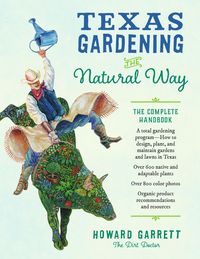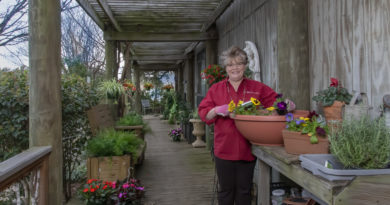Garden ‘the Natural Way’ with step-by-step guide
I don’t have much time to garden, nor do I particularly have a green thumb, but if I did have the time or some semblance of a gardener’s touch, I’d be referring to the 2016 edition of Howard Garrett’s book, “Texas Gardening the Natural Way” (University of Texas Press).
Garrett’s updated edition of his original garden tome written in 2004 walks you through the process of gardening the natural way — from the clearing of the area to mowing the lawn to organic mulching, fertilizing and pest control.
Garrett, known as the Dirt Doctor, takes you step by step through the process of landscape gardening of floral and edible plants, from detoxing contaminated soil to sketching out a plan, just to get things started.
“Successful landscape design is pleasing to the eye, is comfortable, functions as needed, requires moderate care and costs only a little more than you planned,” he writes.
He encourages originality in landscape designs, flexibility, and freedom to make mistakes and improve on your design.
But that’s just the beginning. Page after page includes detailed directions on how to create a garden from choosing the right grass or lawn cover, flowers, trees and shrubs. And if you think you’ve always watered your plants and garden the right way, take a look on Page 11. He’ll direct you on the right watering procedure.
Garrett encourages, and practices, organic gardening, and this book gives you instructions on how to create an organic garden, including how to “Control Pests Naturally.”
“The theory of organic gardening is to do things that improve the health of the soil, water, plants, air and everything else, and all the techniques and products we use do that,” he said in a telephone interview. “What I tell people is No. 1, stop using things that are destructive. Two of those things are synthetic high nitrogen fertilizers that can leach, wash away and volatilize to be part of the air pollution.”
Garrett said only a small percentage of the high nitrogen chemical fertilizers actually get into the plant with 95 percent of it causing pollution.
“And the other is to stop using toxic pesticides,” he implored.
One common product in particular is at the top of his chart is one that he said has been “brilliantly marketed.”
“It’s such a fraud about how dangerous it is that it goes away when it hits the soil and doesn’t affect animals and people. This is incorrect. It is damaging to microorganisms in the soil, bio-organisms and microbes. When bio-organisms go away it starts breaking down. The only thing that has slowed down the use of this product is that farmers see it hurts the microbes and crop production.
“This is the worst of all the pesticides and it’s been so blatantly overused and marketed as this incredibly safe thing, not at all, stop doing things that are destructive, start doing things that amend the life of the soil.”
The third step of going organic, he said, is to use soft pest control, which he discusses in Chapter 9 of his book. “Soft pest control is the beneficial insects and organisms,” he said.
If you have to use an insect repellent, he said use non-killing repellents.
“If all else fails, if you have to kill something use organic pesticides that kill but are the least toxic,” he said.
“Texas Gardening the Natural Way” contains more than 800 photos of 600 native and adapted plants, insects and their control, diseases and their control, and complete planting and maintenance instructions. For more information, visit www.dirtdoctor.com.




